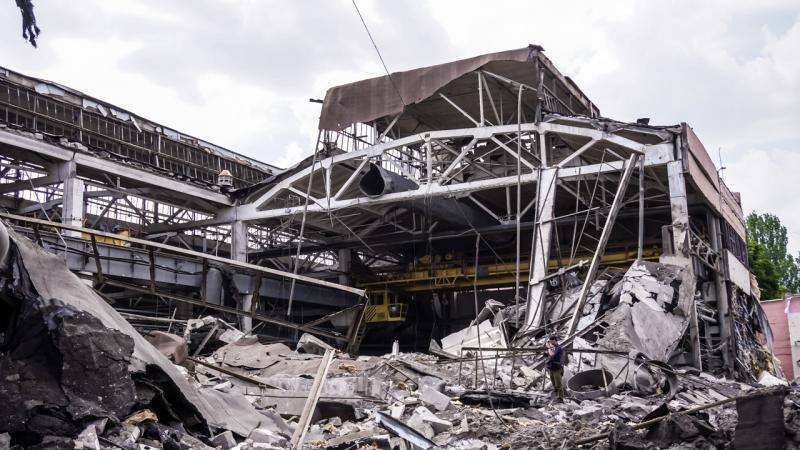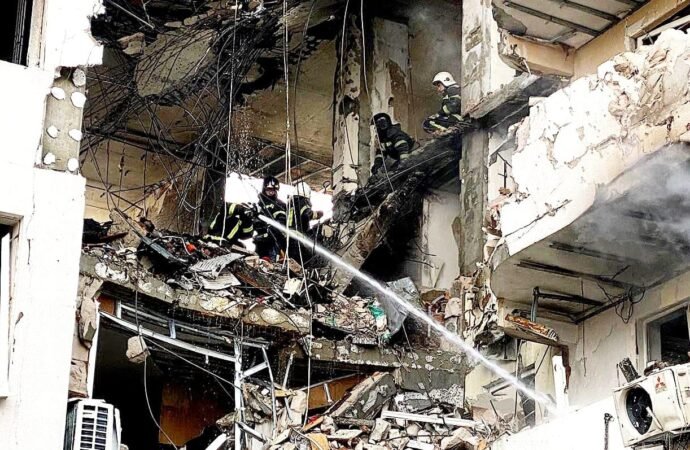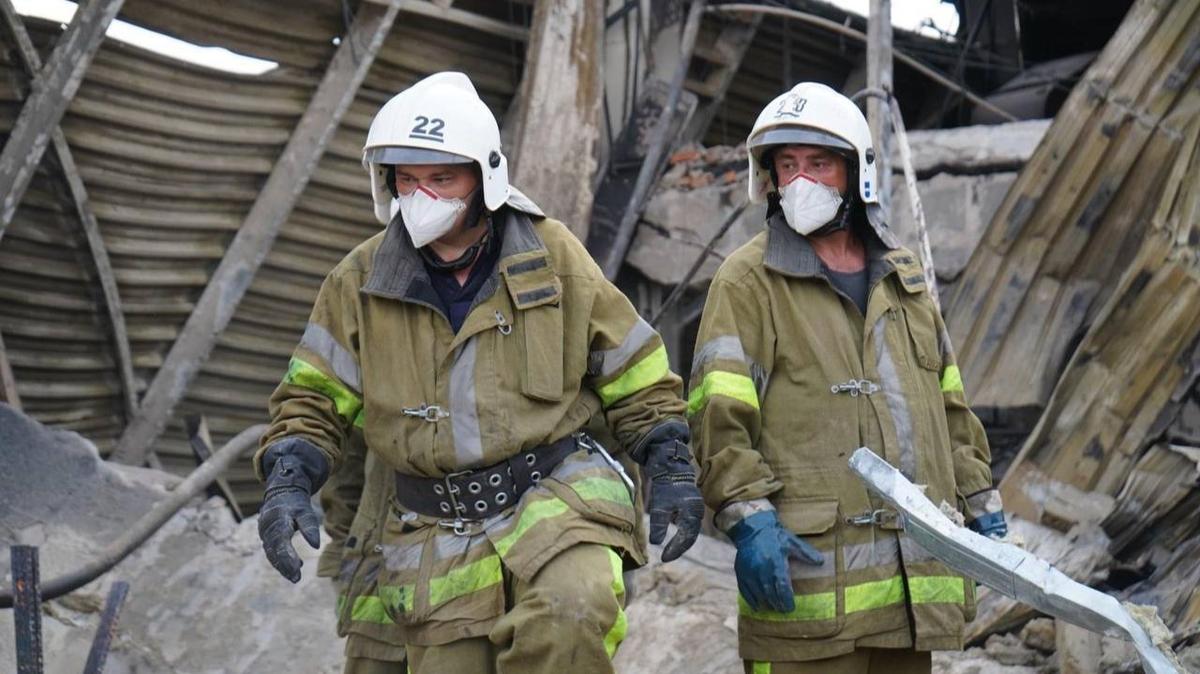Egyptian pharaohs used to inscribe the names of places they destroyed on temple walls. If Putin wanted to make his own list to adorn the wall of the Warhammer church of the Russian Defence Ministry, this week, another place would be added to his record besides the Mariupol Drama Theatre and the kindergarten in Kyiv: the Amstor mall in Kremenchuk.
A downright antique Russian anti-ship missile Kh-22, which is intended for use against aircraft carriers, has done a pretty good job striking the shopping centre. Nearly got top marks. The only thing is that it exploded fifty metres away from it, but when the warhead is stuffed with nearly a tonne of explosives (960 kg), it does not matter much. The walls collapsed, the shopping centre went up in flames, and dozens of people burned alive.
Ten seconds after the first strike, a second missile struck the greenhouses located on the territory of the Kredmash road machinery plant near the shopping centre.
Strictly saying, the first missile also struck Kredmash: in this location, the territory of the plant is adjacent to the mall.
This happened on the day of the G7 summit in Munich. The Russian propaganda immediately went on the offensive. This is fake news, there was no explosion, the corpses were planted there, “this is a Bucha-style provocation”, First Deputy Permanent Representative of Russia to the UN Dmitry Polyansky stated. The icing on the cake was the official statement by the Russian Defence Ministry, which said that there actually was a missile strike, but it was carried out on a military target.
“A high-precision airstrike was conducted by the Russian Aerospace Forces on the hangars that stored ammunition and weapons supplied by the US and European states in the area of the Kremenchuk road machinery plant,” Russian Defence Ministry Spokesman Igor Konashenkov said. And then the ammunition detonated and “led to a fire at a non-functioning shopping mall.”

The debris on the territory of the Kredmash plant. Photo: Telegram channel / kremennews
The missile strike on a shopping centre in Kremenchuk was just a part of a large-scale terror campaign that hit Ukrainian cities. Kharkiv and Mykolaiv are bombarded from Smerch multiple rocket launchers, Odesa and Lviv are hit with Oniks and Kalibr cruise missiles, Kyiv is pounded with Kh-22s launched from Tu-22M bombers from the territory of Belarus.
How can we explain the strike on the shopping centre? What was the mechanism behind it?
Military expert and former Ukrainian fighter pilot Roman Svitan noted that some (only some) of these strikes look the same. The missiles hit the territory of a plant that has a railway access route connected to a hangar. Inside the hangar, there is an overhead crane. The majority of old Soviet plants have all three of these things. Most importantly, this information can easily be found online: plants tend to advertise their loading and unloading equipment.
The Kredmash plant in Kremenchuk and the Artem plant in Kyiv both have this railway access route/hangar/overhead crane combo. Several Kh-22s hit the Artem plant as well: one missile hit a neighbouring building, and the other hit a kindergarten.
Roman Svitan suggested that in all of these cases, the Russian army tried to destroy the locations where NATO weapons and munitions could be stored. The art of reconnaissance has been replaced with the art of eyewash in the Russian army, so the unit tasked with choosing the targets simply looked up which ones follow the criteria: they have a hangar with an overhead crane and a railway route leading up to a hangar.
It happens.
For example, the missile that struck Odesa on 23 April hit a high-rise apartment block, killing a young woman, her mother and her infant daughter. The missile was meant to target the neighbouring airfield, but the thing is that the airfield has not been operational since the 1990s. A flea market was there instead. And yet, the Russian Defence Ministry insisted that it had struck “a logistics terminal at a military airfield”, thus demonstrating that it still gets its information from the maps where the airfield was still shown as operational. Which was in the 1980s.

An apartment block in Odesa following the missile strike on 23 April 2022
So, what could be (I repeat: could be) the mechanism of the Kremenchuk missile strike?
As Western weapons begin to trickle into Ukraine, the nature of this war is starting to change gradually: first in a subtle way, but now, it is becoming clearer. The new 155-caliber Ukrainian artillery demolishes Russian HQs, warehouses and bases. The sheer size of the Russian army and the never-ending ammunition that it ceaselessly wastes along with its manpower, is becoming more of a disadvantage, like the author of this text suggested previously.
Russia cannot succeed at war of attrition which Putin had hoped for, because for this kind of war, you need the rear to be inaccessible to the enemy. But in this case, with the onslaught of Ukrainian drones, spies and high-precision artillery, the rear of the Russian forces is incredibly vulnerable.
Caesar and M777 howitzers destroyed dozens of warehouses in Donetsk, Harpoons attacked the “Boyko Towers” in the Black Sea, HIMARS multiple rocket launchers targeted the air defence systems on Snake Island, S-300 missile systems hit the area near Kherson and possibly a giant warehouse in Krasnyi Luch (Luhansk region).
According to media reports, Putin is personally overseeing the war in Ukraine.
In this situation, it is only natural to give an order to hit back and destroy NATO artillery while it is on its way to the frontlines.
What happens next? We can only assume. The Russian army is highly segmented, and each segment is classified. A separate unit is tasked with determining the targets, and another is tasked with hitting said targets. Those in charge of selecting the targets pick them at random, as we have seen on the example of the “military airfield” in Odesa. The level of their incompetence is truly beyond imagining.
Perhaps they should have an agent network, and instead, they have a bunch of “DPR” (the self-proclaimed Donetsk “people’s republic” — translator’s note) guys who take the money and pick the targets at random, or maybe they just look them up online: alright, here’s a plant with railway access and an overhead crane, let’s hit this one. Or maybe they find a 2015 article that says Kredmash repaired some frontline machinery.
This is the main principle of the Russian army under Putin: why do anything when you can just lie that you did it?
The list is complete. A Tu-22M takes off from an airfield in Kaluga and launches three Kh-22s from the Kursk area.
Kh-22 is not just an old missile. It is a very old missile. Its development began in 1958. It entered service in 1968. There were no iPhones, no MacBooks, no digital electronics at the time. In 1968, thermionic valve receivers were still used. This missile has Neolithic-era microelectronics.

A Kh-22 missile. Photo: Anton Borodin, Museum of Aviation Equipment
Kh-22’s operational range is 600 km. The missile is guided by an inertial navigation system with a gyroscope-stabilized autopilot. Its circular error of probability reaches up to 600 m. It is unlikely to hit an aircraft carrier with this margin of error.
“This is why the majority of modifications of this missile introduce a system at the final stage of its trajectory that helps it hit a contrast target,” Roman Svitan points out.
Do you know how a frog sees? It has four types of retinal cells that can detect “a moving rounded edge”. The ancient Kh-22 sees targets in the same way, which is how it can attack specific radiocontrast targets. When it is launched at ground targets instead of sea vessels, it needs to know how to detect large industrial buildings that are usually separated from other edifices.
When this missile was being developed back in 1958, there were no shopping malls. Even in the USA, they were only starting to appear. Back then, the only standalone large low-rise building was the hangar of a major plant.
At the final stage of the trajectory, our beautiful Pannochka (Ukrainian for young woman, an allusion to Viy, a horror novella by Ukrainian-born Russian writer Nikolai Gogol — translator’s note) blinks her short-sighted eyes wide open and sees a large standalone building. It looks so much bigger than the Kredmash hangars! It is like beer bottles that Australian beetles Julodimorpha bakewelli try to mate with. The beetles mistake a beer bottle for a female, because the bottle has all the features of a female, but it’s so much bigger!
Our half-blind Pannochka, conceived in 1958, is euphoric. This is it. This is a standalone large low-rise industrial building that has all the features of a hangar, only it is bigger and more noticeable.
Pannochka hits the shopping mall, missing it by only 50 metres.
The great geo-strategist in the Kremlin hears the reports saying that his missile hit a shopping mall on the eve of the NATO summit. There are dozens of corpses.
“What happened?” he asks menacingly. And then the Russian army does what it does best: launches a special ass-covering operation.
Do you think they were lying to the West? They couldn’t care less about the West. They were lying to their furious bosses. “We are geniuses.” “We are smart.” “We have the best intelligence in the world.” “We definitely hit the target, Vladimir Vladimirovich, as we reported, but the shrapnel hit the shopping centre.”
The same happened with the Malaysia Airlines plane shot down over eastern Ukraine back in 2014. Back then, they did the same song and dance: “We hit a SU-25, and the SU-25 had hit the Boeing before that.”
This is why Putin will lose this war. No matter how much ammunition and manpower you have, if it is easier for you to lie about doing something than to actually do it, you will lose. Everyone in the Russian army knows that showing initiative does not get you anywhere but being stupid does, and no matter how bad you mess up, you can always just lie about it.
Putin has spent twenty years building this system. It works fine when you use it to carve up Yukos (an oil and gas company that belonged to Russian oligarch Mikhail Khodorkovsky. In 2003, Khodorkovsky was arrested and the company acquired by the government over alleged unpaid taxes — translator’s note). But this strategy is fatal when it comes to war. As Japanese Admiral Isoroku Yamamoto said: “If you start lying, consider the war lost.”

